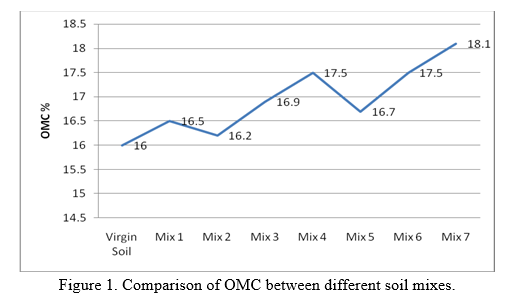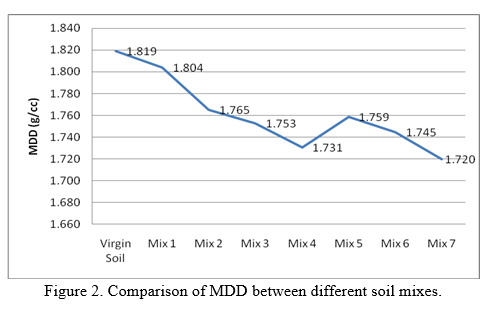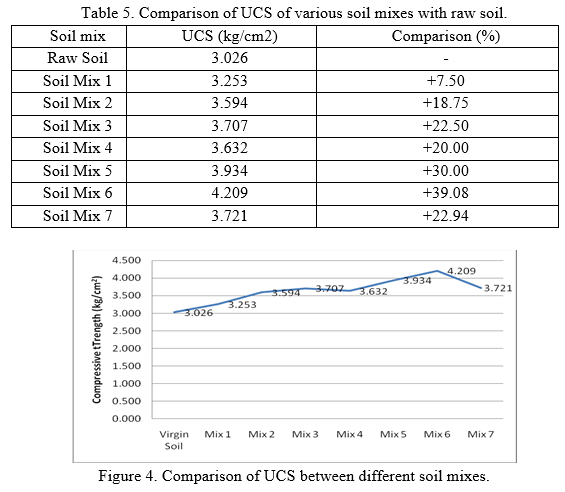Ijraset Journal For Research in Applied Science and Engineering Technology
- Home / Ijraset
- On This Page
- Abstract
- Introduction
- Conclusion
- References
- Copyright
Improving the Engineering Properties of Soil Using Sisal Fibre with Rice Husk Ash
Authors: Vishal Rana, Prof. Vinod Kumar Sonthwal
DOI Link: https://doi.org/10.22214/ijraset.2022.42464
Certificate: View Certificate
Abstract
In the field of civil engineering, stabilization of soil is a procedure to improve and enhance the engineering properties of soil in such a manner that it can withstand heavy loads without any failure. In current work, the behaviour of soil after adding the rice husk ash (fixed proportion 10%) and sisal fibre (varying proportion 0.5%, 0.75% and 1%; varying length 20 mm and 40mm) was studied at different proportions and then different soil properties like, OMC, MDD, CBR value and UCS values were determined. To conclude the present experimental research work, it is suggested to use the combination of Rice husk Ash and Sisal fibre to improve the various engineering properties of soil.
Introduction
I. INTRODUCTION
The process of Soil Stabilization is a modification of soil engineering properties. In the field of civil engineering, stabilization of soil is a procedure to improve and enhance the engineering properties of soil in such a manner that it can withstand heavy loads without any failure. These properties may involve mechanical strengths, aspects such as permeability, compressibility, durability, and plasticity. Physical improvement along with mechanical improvement is simple and usual which is carried out by adding chemical admixtures or by using some other kind of machine such as rollers etc.
The endurance of the soil is one of the imperative factors which affect the construction process of any structure. To obtain the excellent performance of buildings built on such soils, the performance characteristics of the same soil need to be adjusted as per the requirement of the construction project. The bad engineering behaviour and performance of soil have led engineers to make different attempts to improve the poor engineering properties of soils. Stabilization of the soil is commonly needed when the soil under the foundation for any type of construction (i.e. road or buildings) is not suitable to bear the super structural load. This method is a remedial measure that helps in reducing settlement, permeability, and compressibility of the soil mass and increases its shear strength.
Following are the methods through which soil is stabilized:
- Mechanical Stabilization: The most traditional type of soil stabilization technique is mechanical stabilization. This method entails altering the property of the soil physically so that its gradation, solidity, and other soil characteristics are affected. Eventually, dense and well-graded soil can be obtained by proper mixing and compacting more than one soil of various grades. In this process, the mixing, rolling, and compacting techniques are used.
- Lime Stabilization: This process of stabilization is done by adding lime to the reactive soil that gives long-term strength to the soil with the help of a pozzolanic reaction between the soil and lime. In this process, the production of calcium silicate hydrates and calcium aluminate hydrates takes place. This method is being utilized throughout the world on a very large scale. It is a form of chemical stabilization.
- Cement Stabilization: the addition of cement to the soft soil at a predefined proportion (depending on the soil type) to stabilize the soil. Cement, in soil, acts as a binding agent that adheres strength to the soil. Cement stabilization is very uneconomical process and therefore, it is not used for small projects. It is a form of chemical stabilization.
- Bituminous Stabilization: Bituminous soil stabilization is defined as a process by which a controlled proportion of bituminous material is completely and properly mixed with an existing soft soil material to gain firm strength. with the help of Bitumen, the cohesive and load-bearing properties of the soil increase and become impermeable.
- Stabilization by Geotextile and Fabrics: Geotextiles are regularly applied to divide two layers of soil with different particle sizes that retain their integrity and function between the layers. When water percolates, the geotextile prevents the soils from mixing together. Having geotextile or fabric for the soil stabilizing process means enhanced tensile strength, permeability, permittivity apparent opening size etc.
- Recycled and Waste Products: As the quantity of waste material in the world is increasing day by day, many researchers have used such material in the soil stabilization process that gives phenomenon end-results. fly ash, rice husk ash, marble powder, fibres, etc are being widely for stabilizing soft soils. this not only becomes economical but also enhances the soil properties and reduces the impact of such waste material on the environment which results in eco-friendly material.
There are many benefits of soil stabilization and some of them are mentioned below:
a. It prevents erosion and sedimentation.
b. It creates barriers that prevent the movement of air and water over the soil which helps in binding of the soil particles.
c. It enhances the weak soil’s strength.
d. Facilitates keeping the soil intact, which facilitates the growth of plants that further helps in a more robust structure.
e. Longer lasting results of soil stabilization in road construction have positive influence on the environment, saving energy, materials and equipment.
f. Offers strength improvement including shearing strength and compressive strength
g. Mitigates and reduces volume instability and swelling potential and controlling shrinkage
h. Reduces plasticity index (PI), permeability, soil compressibility, deformation and settlement, clay/silt-sized particles, and improves resilient modulus, durability to resist unfavourable environmental conditions such as freeze-thaw or wet-dry cycles, erosion and weathering
i. It offers Dust control and waterproofing.
II. RESEARCH METHODLOGY
This portion discusses the methodology of current experimental work i.e. stabilizing weak soil by using rice husk ash (fixed proportion 10%) and sisal fibre (varying proportion 0.5%, 0.75% and 1%; varying length 20 mm and 40mm) as shown in table 1.. All the laboratory tests have been mentioned with which the effect of sisal fibre and rice husk ash was assessed. The research methodology is mentioned as under:
- Raw soil sample was obtained from the vicinity area.
- Determination of Liquid limit, plastic limit and plasticity index was done to determine the type of soil.
- The effect on dry density and optimum moisture content due to the addition of rice husk ash (fixed proportion 10%) and sisal fiber (varying proportion 0.5%, 0.75% and 1%; varying length 20 mm and 40mm) to the soil.
- The effect of rice husk ash (fixed proportion) and sisal fiber (varying proportion and length) on soil on its CBR value was assessed.
- The effect on Unconfined Compressive Strength (UCS) of soil was also determined.
Table 1. Different Soil Mixes.
|
Soil mix |
Rice Husk Ash (%) |
Sisal Fibre (%) |
Sisal Length |
|
Virgin Soil |
- |
- |
- |
|
Soil Mix 1 |
10 |
- |
- |
|
Soil Mix 2 |
10 |
0.50 |
2 cm |
|
Soil Mix 3 |
10 |
0.75 |
2 cm |
|
Soil Mix 4 |
10 |
1.00 |
2 cm |
|
Soil Mix 5 |
10 |
0.50 |
4 cm |
|
Soil Mix 6 |
10 |
0.75 |
4 cm |
|
Soil Mix 7 |
10 |
1.00 |
4 cm |
Following are the laboratory Tests that were conducted during the study:
a. Plastic limit
b. Liquid Limit
c. Plasticity index
d. Specific Gravity
e. Compaction Proctor Test
f. California Bearing Ratio (CBR)
g. Unconfined Compressive Strength (UCS)
III. RESULTS
The collected raw soil was tested for its atterberg’s limit and other soil index properties to assess the classification of soil as per Indian Standard Soil Classification System. The test results are shown in table: 2.
Table: 2. Soil Properties and Classification.
|
S. No. |
Test Name |
Obtained values |
|
1 |
Liquid Limit (wL) |
39.58 % |
|
2 |
Plastic Limit (wp) |
22.16 % |
|
3 |
Plasticity Index(PI) |
17.42 |
|
4 |
Classification of Soil as per IS |
CI |
|
5 |
Percentage Finer |
52.42 % |
|
6 |
Specific Gravity |
2.54 |
A. Test Results for OMC & MDD
From the table 3, it was observed that the optimum moisture content increases when the rice husk ash was added however, the maximum dry density of the soil decreases after addition of RHA. Moreover, the addition of sisal fibre (2 cm and 4 cm long) initially decreases the OMC value but then as the percentage of fibre increases, the OMC tends to increase as well. On the contrary, the MDD value keeps on decreasing as the percentage of sisal fibre increases.
(see fig. 1 & 2)
Table 3. Comparison of OMC and MDD of various soil mixes with raw soil.
|
Soil mix |
OMC (%) |
MDD (g/cc) |
Comparison of MDD (%) |
|
Raw Soil |
16 |
1.819 |
- |
|
Soil Mix 1 |
16.5 |
1.804 |
-0.82 |
|
Soil Mix 2 |
16.2 |
1.765 |
-2.97 |
|
Soil Mix 3 |
16.9 |
1.753 |
-3.63 |
|
Soil Mix 4 |
17.5 |
1.731 |
-4.84 |
|
Soil Mix 5 |
16.7 |
1.759 |
-3.30 |
|
Soil Mix 6 |
17.5 |
1.745 |
-4.07 |
|
Soil Mix 7 |
18.1 |
1.720 |
-5.44 |


B.Test Results for California Bearing Ratio
From the table 4, after determining the CBR values of raw and other soil mixes, it was observed that with the addition of RHA and Sisal Fibre, the CBR value of different soil mixes increases when compared to the CBR value of raw soil. The CBR value increases approximately 55% when 10% RHA was added when compared to the CBR value of Raw soil. The maximum CBR value was attained for the soil mix 6 (10% RHA + 0.75% sisal fibre of length 4cm) i.e. 6.9, approximately 113%. After soil mix 6, the CBR value slightly decreases. (see fig. 1 & 3)

C. Test Results for Unconfined Compressive Strength
From the table 5, after determining the UCS of raw and other soil mixes, it was observed that with the addition of RHA and Sisal Fibre, the UCS of different soil mixes increases when compared to the UCS of raw soil. The UCS increases approximately 7.5% when 10% RHA was added when compared to the UCS of Raw soil. The experimental work on the sample having 10% RHA and 0.75% sisal fibre of length 4cm sisal fibre shows the maximum UCS i.e. 4.209 kg/cm2 that is approximately 40% more than the UCS of raw soil. (see fig. 4)

Conclusion
After conducting various laboratory tests on various samples of soil, the present study has arrived to the following conclusions: 1) The values of Optimum Moisture Content (OMC) and Maximum Dry Density obtained for the raw soil were 16% and 1.819 g/cc respectively 2) It was concluded that the optimum moisture content increases when the rice husk ash was added however, the maximum dry density of the soil decreases after addition of RHA. Moreover, the addition of sisal fibre (2 cm and 4 cm long) initially decreases the OMC value but then as the percentage of fibre increases, the OMC tends to increase as well. On the contrary, the MDD value keeps on decreasing as the percentage of sisal fibre increases. The maximum decrease in MDD was approximately 5.5% when compared to the MDD of raw soil. 3) It was concluded that with the addition of RHA and Sisal Fibre, the CBR value of different soil mixes increases when compared to the CBR value of raw soil. The CBR value increases approximately 55% when 10% RHA was added when compared to the CBR value of Raw soil. The maximum CBR value was attained for the soil mix 6 (10% RHA + 0.75% sisal fibre of length 4cm) i.e. 6.9, approximately 113%. After soil mix 6, the CBR value slightly decreases. 4) It was concluded that with the addition of RHA and Sisal Fibre, the UCS of different soil mixes increases when compared to the UCS of raw soil. The UCS increases approximately 7.5% when 10% RHA was added when compared to the UCS of Raw soil. The experimental work on the sample having 10% RHA and 0.75% sisal fibre of length 4cm sisal fibre shows the maximum UCS i.e. 4.209 kg/cm2 that is approximately 40% more than the UCS of raw soil. To conclude the present experimental research work in the gist, it is suggested to use the combination of Rice husk Ash and Sisal fibre to improve the various engineering properties of soil.
References
[1] Musa, (2007) “Effect of Rice Husk Ash on Cement Stabilized Laterite” Leonardo Electronic Journal of Practices and Technologies, pp-47-58. [2] Prof.S.Ayyappan, Ms.K.Hemalatha and Prof.M.Sundaram(2010) “Investigation of Engineering Behavior of Soil, Polypropylene Fibres and Fly Ash -Mixtures for Road Construction’’ International Journal of Environmental Science and Development. [3] H.S. Chore, S.S. Shinde and S.S. Dhole (2011) “Performance evaluation of polypropylene fibres on sand-fly ash mixtures in highways” Journal of Civil Engineering (IEB) [4] S. Sharma, Ravi Kumar; Babita, (2013) “Modification of Clayey Soil Using Fly Ash,” IJRET Int. J. Res. Eng. Technol., vol. 02, no. 10, pp. 356–361. [5] Y. Wu, Y. Li, and B. Nui, (2014) “Assessment of the Mechanical Properties of Sisal FiberReinforced Silty Clay Using Tri-axial Shear Tests,” ScientificWorldJournal., Vol. 2014, p. 9. [6] Amit S. Kharade, et.al, (2014) “Waste Product ‘Bagasse Ash’ From Sugar Industry Can Be Used as Stabilizing Material for Expansive Soils” IJRET: International Journal of Research in Engineering and Technology, pp 506-512. [7] Shish Pal, Vinod Kumar Sonthwal, Jasvir S Rattan(2015) “Soil Stabilisation Using Polypropylene as Waste Fibre Material’’. [8] Arvind Kumar, (2015) “Behavior of cement-stabilized fiber-reinforced pond ash, rice husk ash soil mixtures” ELSEVIER, pp- 1-9. [9] A. Mathew and K. Y. Raneesh, (2016) “Effect on Strength Characteristics of Expansive Soil Using Sisal Fibre and Waste Materials,” vol. 5, no. 9, pp. 1702–1707. [10] Paulo J. Venda Oliveira, António A.S. Correia, João C.A. Cajada, (2018) “Effect of The Type of Soil On the Cyclic Behaviour of Chemically Stabilised Soils Unreinforced and Reinforced with Polypropylene Fibres” Soil Dynamics and Earthquake Engineering-ELSEVIER, pp- 336-343. [11] Ravinder Singh Panwar, Vinod Kumar Sonthwal, Sunil Kaswan (2018) “Enhancing The Engineering Properties of Soil by Using Sisal Fibre and Fly Ash” International Journal of Technical Innovation in Modern Engineering & Science (IJTIMES), Volume 4, Issue 7, pp-730-735. [12] Ahmed Elkhebu, Adnan Zainorabidin, AfshinAsadi, Ismail H. Bakar, Bujang B.K. Huat, LokmaneAbdeldjouad, WisamDheyab(2019) “Effect of incorporating multifilament polypropylene fibers into alkaline activated fly ash soil mixtures” Soil and Foundation -ELSEVIER, pp- 2144-2154. [13] Sachin Verma, VidyaSagarKhanduri, Anupam Mittal (2020) “Stabilization of colluvial soil using rice husk ash and micro silica powder” Materials Today:proceedings -ELSEVIER, https://doi.org/10.1016/j.matpr.2020.04.019 [14] IS-2720(XVI), “Laboratory determination of CBR,” Indian Stand., 1987. [15] IRC, “Guidelines for the Design of Flexible Pavements for Low Volume Rural Roads.” p. 40, 2007. [16] IS.2720.2, “Determination of water content,” 1973. [17] IS-2720(III), “Determination of specific gravity,” Indian Stand., 1980. [18] IS 2720(IV), “Grain Size Analysis,” Indian Stand., 1985.
Copyright
Copyright © 2022 Vishal Rana, Prof. Vinod Kumar Sonthwal. This is an open access article distributed under the Creative Commons Attribution License, which permits unrestricted use, distribution, and reproduction in any medium, provided the original work is properly cited.

Download Paper
Paper Id : IJRASET42464
Publish Date : 2022-05-10
ISSN : 2321-9653
Publisher Name : IJRASET
DOI Link : Click Here
 Submit Paper Online
Submit Paper Online

